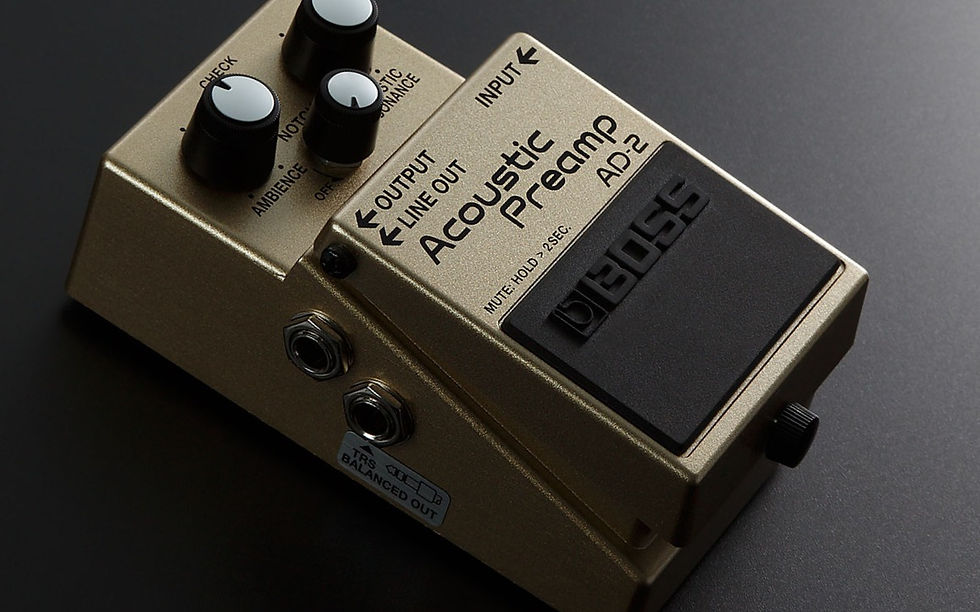Review: 1981 Inventions DRV
- Nick Rambo
- Feb 15, 2020
- 3 min read
Updated: Nov 13, 2020

The RAT has always been around the music I like — and I’ve owned a number of them over the years — but, strangely, it doesn’t feel like RAT-style distortion is a tone I’ve ever intentionally chased.
Now, as a consummate pedal addict, I’ve had old-school, real-deal LM308-equipped RATs, cheap chinese knockoffs, boutique RAT recreations and most things in between — but when I first noticed the hype around the DRV from 1981 Inventions and saw conversation around it being a RAT clone, I mostly wrote it off.
That changed when I met its co-creator, Matthew Hoopes at Winter NAMM and got to play one myself.
Our dialogue started with me gesturing to the DRV and I saying, “It’s just a RAT clone, right?”
How embarrassing.
To call this pedal a “RAT clone” is a something of a misnomer. Does it have decidedly RAT-like qualities? Sure. But it doesn’t sound or feel like any RAT I’ve stepped on before.
Nuance
When I suggested to Matthew Hoopes that the DRV was “...just a RAT clone” his reply was something along the lines of, ‘Well, kinda, but it’s more nuanced.’
How true.
In a world full of 3-knob distortion boxes, it’s tough to stand out. Partially because there are so many to choose from, but also because it feels like modern pedal designers have figured out that modern players need more. But for Hoopes, the choice to stick at 3 controls was intentional.
"Too many knobs on a distortion device is not only overwhelming, it just doesn’t feel right,” he says. “Being from the Rust Belt — Ohio — I have always loved the blue-collar vibe of the Rat, so the goal of the DRV was to make something that had a lot of subtlety and nuance, but that sounded classic.”
And though I’ve decried 3-knob gain pedals in the past, I’ve got to tell you: there’s such an intuitiveness to the DRV that I think it achieves something other RAT-inspired pedals don't.
Subtlety
The idea of approaching a RAT-based distortion as a low- to mid-gainer is somewhat perplexing to me. It’s not that the original Pro Co circuit can't sound good at lower gain settings, just — that’s not what it’s best at. But the DRV is decidedly different.
“I like to describe the uniqueness of the low gain section of the DRV most,” Hoopes told me. “When the gain is lower, the mid-range is more pronounced, making it more like an overdrive than a distortion, but not quite either. It also does this cool thing that I have not heard where the preamp / boost meets distortion. Also, the max gain is super interesting to me. You can crank the gain, and completely open up the high-cut knob, and it stays within a ‘nice’ type of sound.”
And that’s it, I guess — the DRV is the 'nicest' RAT you’ll find these days.
How quaint.
The added complexity of having a preamp in front of the drive section, along with the EQ shifting and lower overall gain makes it more controllable, more utilitarian and helps it sit right in just about any mix.
Parting Shots
I mentioned this earlier, but playing the DRV — even for the first time — felt very intuitive. Now, of course, it’s only a 3-knob drive pedal… but what’s still interesting to me even now is that no matter where I set the knobs, the sound I want and expect is the sound I hear. And rather than narrow sections where the only good sounds are found — as I’ve found in previous experiences with similar pedals — the DRV sounds good basically everywhere on every knob, from the lowest gain and cut setting to the highest.
And, of course, the visual design is next level if you’re into clean lines and utilitarianism.
“I love minimalism,” Matthew says. “But I do think about aesthetic and how things make me feel, That means a lot to me.”
And you can tell.
How nice.
Watch my demo of the DRV here
Read my full-length interview with Matthew Hoopes here



![Review: Kingsley Minstrel [v2]](https://static.wixstatic.com/media/286ec4_102acaa50c884b40bd5307c6713b6dd2~mv2.jpg/v1/fill/w_512,h_468,al_c,q_80,enc_avif,quality_auto/286ec4_102acaa50c884b40bd5307c6713b6dd2~mv2.jpg)

Comments